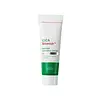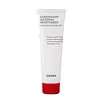What's inside
What's inside
 Key Ingredients
Key Ingredients

 Benefits
Benefits

 Concerns
Concerns

 Ingredients Side-by-side
Ingredients Side-by-side

Centella Asiatica Extract
CleansingGlycerin
HumectantDicaprylyl Carbonate
Emollient1,2-Hexanediol
Skin ConditioningHydrogenated Polydecene
EmollientNiacinamide
SmoothingWater
Skin ConditioningMelaleuca Alternifolia Leaf Extract
PerfumingMadecassoside
AntioxidantMadecassic Acid
Skin ConditioningAsiaticoside
AntioxidantAsiatic Acid
Skin Conditioning4-Terpineol
MaskingCeramide NP
Skin ConditioningPanthenol
Skin ConditioningAllantoin
Skin ConditioningSodium Hyaluronate
HumectantCandida Bombicola/Glucose/Methyl Rapeseedate Ferment
AntimicrobialCaprylyl Methicone
Skin ConditioningVinyldimethicone
Hydroxyethyl Acrylate/Sodium Acryloyldimethyl Taurate Copolymer
Emulsion StabilisingAcrylates/C10-30 Alkyl Acrylate Crosspolymer
Emulsion StabilisingPolymethylsilsesquioxane
Dimethiconol
EmollientSodium Acrylates Copolymer
Tromethamine
BufferingCetyl Ethylhexanoate
EmollientCaprylic/Capric Triglyceride
MaskingEthylhexyl Palmitate
EmollientDipropylene Glycol
HumectantButylene Glycol
HumectantEthylhexylglycerin
Skin ConditioningLecithin
EmollientCarbomer
Emulsion StabilisingXanthan Gum
EmulsifyingSorbitan Isostearate
EmulsifyingHydrogenated Lecithin
EmulsifyingDisodium EDTA
Glyceryl Acrylate/Acrylic Acid Copolymer
HumectantPvm/Ma Copolymer
Emulsion StabilisingOlea Europaea Fruit Oil
MaskingPentylene Glycol
Skin ConditioningHydroxyacetophenone
AntioxidantCaprylyl Glycol
EmollientGlycolipids
Skin ConditioningCentella Asiatica Extract, Glycerin, Dicaprylyl Carbonate, 1,2-Hexanediol, Hydrogenated Polydecene, Niacinamide, Water, Melaleuca Alternifolia Leaf Extract, Madecassoside, Madecassic Acid, Asiaticoside, Asiatic Acid, 4-Terpineol, Ceramide NP, Panthenol, Allantoin, Sodium Hyaluronate, Candida Bombicola/Glucose/Methyl Rapeseedate Ferment, Caprylyl Methicone, Vinyldimethicone, Hydroxyethyl Acrylate/Sodium Acryloyldimethyl Taurate Copolymer, Acrylates/C10-30 Alkyl Acrylate Crosspolymer, Polymethylsilsesquioxane, Dimethiconol, Sodium Acrylates Copolymer, Tromethamine, Cetyl Ethylhexanoate, Caprylic/Capric Triglyceride, Ethylhexyl Palmitate, Dipropylene Glycol, Butylene Glycol, Ethylhexylglycerin, Lecithin, Carbomer, Xanthan Gum, Sorbitan Isostearate, Hydrogenated Lecithin, Disodium EDTA, Glyceryl Acrylate/Acrylic Acid Copolymer, Pvm/Ma Copolymer, Olea Europaea Fruit Oil, Pentylene Glycol, Hydroxyacetophenone, Caprylyl Glycol, Glycolipids
Propolis Extract
Skin ConditioningAloe Barbadensis Leaf Water
MaskingCamellia Sinensis Leaf Water
MaskingButylene Glycol
HumectantCetyl Ethylhexanoate
EmollientGlycerin
Humectant1,2-Hexanediol
Skin ConditioningNiacinamide
SmoothingHydroxyethyl Acrylate/Sodium Acryloyldimethyl Taurate Copolymer
Emulsion StabilisingCyclomethicone
EmollientCetearyl Olivate
Betaine
HumectantCetearyl Alcohol
EmollientSorbitan Olivate
EmulsifyingPanthenol
Skin ConditioningEthylhexylglycerin
Skin ConditioningAllantoin
Skin ConditioningXanthan Gum
EmulsifyingDimethicone/Vinyl Dimethicone Crosspolymer
Skin ConditioningSodium Hyaluronate
HumectantArginine
MaskingZinc PCA
HumectantBetaine Salicylate
AntimicrobialMentha Haplocalix Extract
MaskingMenthyl Lactate
MaskingCitric Acid
BufferingMelaleuca Alternifolia Leaf Oil
AntioxidantAsiaticoside
AntioxidantAsiatic Acid
Skin ConditioningMadecassic Acid
Skin ConditioningPropolis Extract, Aloe Barbadensis Leaf Water, Camellia Sinensis Leaf Water, Butylene Glycol, Cetyl Ethylhexanoate, Glycerin, 1,2-Hexanediol, Niacinamide, Hydroxyethyl Acrylate/Sodium Acryloyldimethyl Taurate Copolymer, Cyclomethicone, Cetearyl Olivate, Betaine, Cetearyl Alcohol, Sorbitan Olivate, Panthenol, Ethylhexylglycerin, Allantoin, Xanthan Gum, Dimethicone/Vinyl Dimethicone Crosspolymer, Sodium Hyaluronate, Arginine, Zinc PCA, Betaine Salicylate, Mentha Haplocalix Extract, Menthyl Lactate, Citric Acid, Melaleuca Alternifolia Leaf Oil, Asiaticoside, Asiatic Acid, Madecassic Acid
 Reviews
Reviews

Ingredients Explained
These ingredients are found in both products.
Ingredients higher up in an ingredient list are typically present in a larger amount.
1,2-Hexanediol is a synthetic liquid and another multi-functional powerhouse.
It is a:
- Humectant, drawing moisture into the skin
- Emollient, helping to soften skin
- Solvent, dispersing and stabilizing formulas
- Preservative booster, enhancing the antimicrobial activity of other preservatives
Allantoin is a soothing ingredient known for its protective and moisturizingg properties. Because of this, it is often added to products with strong active ingredients.
Studies show higher concentrations of this ingredient can promote wound healing.
Though it can be derived from the comfrey plant, allantoin is produced synthetically for cosmetic products to ensure purity.
Learn more about AllantoinAsiatic Acid is a major component of Centella Asiatica Extract. It has wound-healing, anti-inflammatory, and antioxidant properties.
Studies show Asiatic Acid is able to block the pathway for skin inflammation receptors, helping to soothe skin.
As an antioxidant, asiatic acid helps protect our skin against damaging environmental factors.
Learn more about Asiatic AcidAsiaticoside comes from the super popular skin-soothing ingredient, Centella asiatica. It is one of four active compounds found in the extract of Centella Asiatica.
Asiaticoside is an antioxidant and helps with wound healing. It has been shown to increase antioxidant activity during the wound healing process.
Butylene Glycol (or BG) is used within cosmetic products for a few different reasons:
Overall, Butylene Glycol is a safe and well-rounded ingredient that works well with other ingredients.
Though this ingredient works well with most skin types, some people with sensitive skin may experience a reaction such as allergic rashes, closed comedones, or itchiness.
Learn more about Butylene GlycolCetyl Ethylhexanoate is an emollient ester. It comes from cetearyl alcohol and 2-ethylhexanoic acid.
Cetyl Ethylhexanoate is an emollient that adds a velvety feel to skin without being greasy or oily. Emollients help trap moisture into your skin, keeping your skin soft and hydrated.
Ethylhexylglycerin (we can't pronounce this either) is commonly used as a preservative and skin softener. It is derived from glyceryl.
You might see Ethylhexylglycerin often paired with other preservatives such as phenoxyethanol. Ethylhexylglycerin has been found to increase the effectiveness of these other preservatives.
Glycerin is already naturally found in your skin. It helps moisturize and protect your skin.
A study from 2016 found glycerin to be more effective as a humectant than AHAs and hyaluronic acid.
As a humectant, it helps the skin stay hydrated by pulling moisture to your skin. The low molecular weight of glycerin allows it to pull moisture into the deeper layers of your skin.
Hydrated skin improves your skin barrier; Your skin barrier helps protect against irritants and bacteria.
Glycerin has also been found to have antimicrobial and antiviral properties. Due to these properties, glycerin is often used in wound and burn treatments.
In cosmetics, glycerin is usually derived from plants such as soybean or palm. However, it can also be sourced from animals, such as tallow or animal fat.
This ingredient is organic, colorless, odorless, and non-toxic.
Glycerin is the name for this ingredient in American English. British English uses Glycerol/Glycerine.
Learn more about GlycerinThis is a synthetic polymer. It helps improve the texture of products by adding thickness and gel-like feel.
It is also an emulsifer, meaning it prevents ingredients such as oil and water from separating. It also helps evenly disperse other ingredients.
Madecassic Acid is a major component of Centella Asiatica Extract. It has anti-inflammatory and antioxidant properties.
It is a triterpenoid, meaning it naturally acts as an antioxidant. Antioxidants protect your skin against damage from environmental factors such as pollution and UV.
Studies show Madecassic Acid helps soothe the skin due to its ability to block inflammation pathways.
Learn more about Madecassic AcidNiacinamide is a multitasking form of vitamin B3 that strengthens the skin barrier, reduces pores and dark spots, regulates oil, and improves signs of aging.
And the best part? It's gentle and well-tolerated by most skin types, including sensitive and reactive skin.
You might have heard of "niacin flush", or the reddening of skin that causes itchiness. Niacinamide has not been found to cause this.
In very rare cases, some individuals may not be able to tolerate niacinamide at all or experience an allergic reaction to it.
If you are experiencing flaking, irritation, and dryness with this ingredient, be sure to double check all your products as this ingredient can be found in all categories of skincare.
When incorporating niacinamide into your routine, look out for concentration amounts. Typically, 5% niacinamide provides benefits such as fading dark spots. However, if you have sensitive skin, it is better to begin with a smaller concentration.
When you apply niacinamide to your skin, your body converts it into nicotinamide adenine dinucleotide (NAD). NAD is an essential coenzyme that is already found in your cells as "fuel" and powers countless biological processes.
In your skin, NAD helps repair cell damage, produce new healthy cells, support collagen production, strengthen the skin barrier, and fight environmental stressors (like UV and pollution).
Our natural NAD levels start to decline with age, leading to slower skin repair, visible aging, and a weaker skin barrier. By providing your skin niacinamide, you're recharging your skin's NAD levels. This leads to stronger, healthier, and younger looking skin.
Another name for vitamin B3 is nicotinamide. This vitamin is water-soluble and our bodies don't store it. We obtain Vitamin B3 from either food or skincare. Meat, fish, wheat, yeast, and leafy greens contain vitamin B3.
The type of niacinamide used in skincare is synthetically created.
Learn more about NiacinamidePanthenol is a common ingredient that helps hydrate and soothe the skin. It is found naturally in our skin and hair.
There are two forms of panthenol: D and L.
D-panthenol is also known as dexpanthenol. Most cosmetics use dexpanthenol or a mixture of D and L-panthenol.
Panthenol is famous due to its ability to go deeper into the skin's layers. Using this ingredient has numerous pros (and no cons):
Like hyaluronic acid, panthenol is a humectant. Humectants are able to bind and hold large amounts of water to keep skin hydrated.
This ingredient works well for wound healing. It works by increasing tissue in the wound and helps close open wounds.
Once oxidized, panthenol converts to pantothenic acid. Panthothenic acid is found in all living cells.
This ingredient is also referred to as pro-vitamin B5.
Learn more about PanthenolSodium Hyaluronate is hyaluronic acid's salt form. It is commonly derived from the sodium salt of hyaluronic acid.
Like hyaluronic acid, it is great at holding water and acts as a humectant. This makes it a great skin hydrating ingredient.
Sodium Hyaluronate is naturally occurring in our bodies and is mostly found in eye fluid and joints.
These are some other common types of Hyaluronic Acid:
Learn more about Sodium HyaluronateXanthan gum is used as a stabilizer and thickener within cosmetic products. It helps give products a sticky, thick feeling - preventing them from being too runny.
On the technical side of things, xanthan gum is a polysaccharide - a combination consisting of multiple sugar molecules bonded together.
Xanthan gum is a pretty common and great ingredient. It is a natural, non-toxic, non-irritating ingredient that is also commonly used in food products.
Learn more about Xanthan Gum